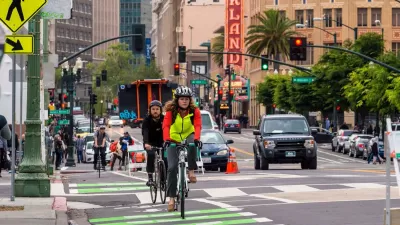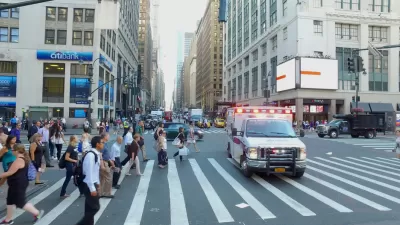Taking Vision Zero beyond the local level.

"[F]ederal safety agencies are stepping in with an ambitious strategy to completely eliminate road fatalities nationwide by 2050," according to an article by Alissa Walker.
Walker is sharing insight into the Road to Zero report—released recently by the National Safety Council, working closely with the U.S. Department of Transportation and "over 600 industry groups"—as the first national strategy to eliminate traffic fatalities.
"Key recommendations from the report confirm that the Vision Zero strategy is working—focusing on physical changes to the urban streetscape that are known to save lives," writes Walker. "The report cites specific improvements as particularly effective, like narrowing crossing distances using curb extensions or reprogramming walk signals to give pedestrians a head start at intersections (known as a Leading Pedestrian Interval, or LPI)."
"The report also champions what’s called a “safe systems” approach for transportation planning—integrating life-saving improvements consistently and universally into every roadway, where unforgiving design currently makes errors deadly," adds Walker.
The article includes a lot more insight into the actions proposed by the report, as well as the traffic engineering and transportation planning context that shapes the need for the report.
FULL STORY: U.S. sets a nationwide goal to end traffic deaths by 2050

Planetizen Federal Action Tracker
A weekly monitor of how Trump’s orders and actions are impacting planners and planning in America.

Map: Where Senate Republicans Want to Sell Your Public Lands
For public land advocates, the Senate Republicans’ proposal to sell millions of acres of public land in the West is “the biggest fight of their careers.”

Restaurant Patios Were a Pandemic Win — Why Were They so Hard to Keep?
Social distancing requirements and changes in travel patterns prompted cities to pilot new uses for street and sidewalk space. Then it got complicated.

Platform Pilsner: Vancouver Transit Agency Releases... a Beer?
TransLink will receive a portion of every sale of the four-pack.

Toronto Weighs Cheaper Transit, Parking Hikes for Major Events
Special event rates would take effect during large festivals, sports games and concerts to ‘discourage driving, manage congestion and free up space for transit.”

Berlin to Consider Car-Free Zone Larger Than Manhattan
The area bound by the 22-mile Ringbahn would still allow 12 uses of a private automobile per year per person, and several other exemptions.
Urban Design for Planners 1: Software Tools
This six-course series explores essential urban design concepts using open source software and equips planners with the tools they need to participate fully in the urban design process.
Planning for Universal Design
Learn the tools for implementing Universal Design in planning regulations.
Heyer Gruel & Associates PA
JM Goldson LLC
Custer County Colorado
City of Camden Redevelopment Agency
City of Astoria
Transportation Research & Education Center (TREC) at Portland State University
Camden Redevelopment Agency
City of Claremont
Municipality of Princeton (NJ)





























